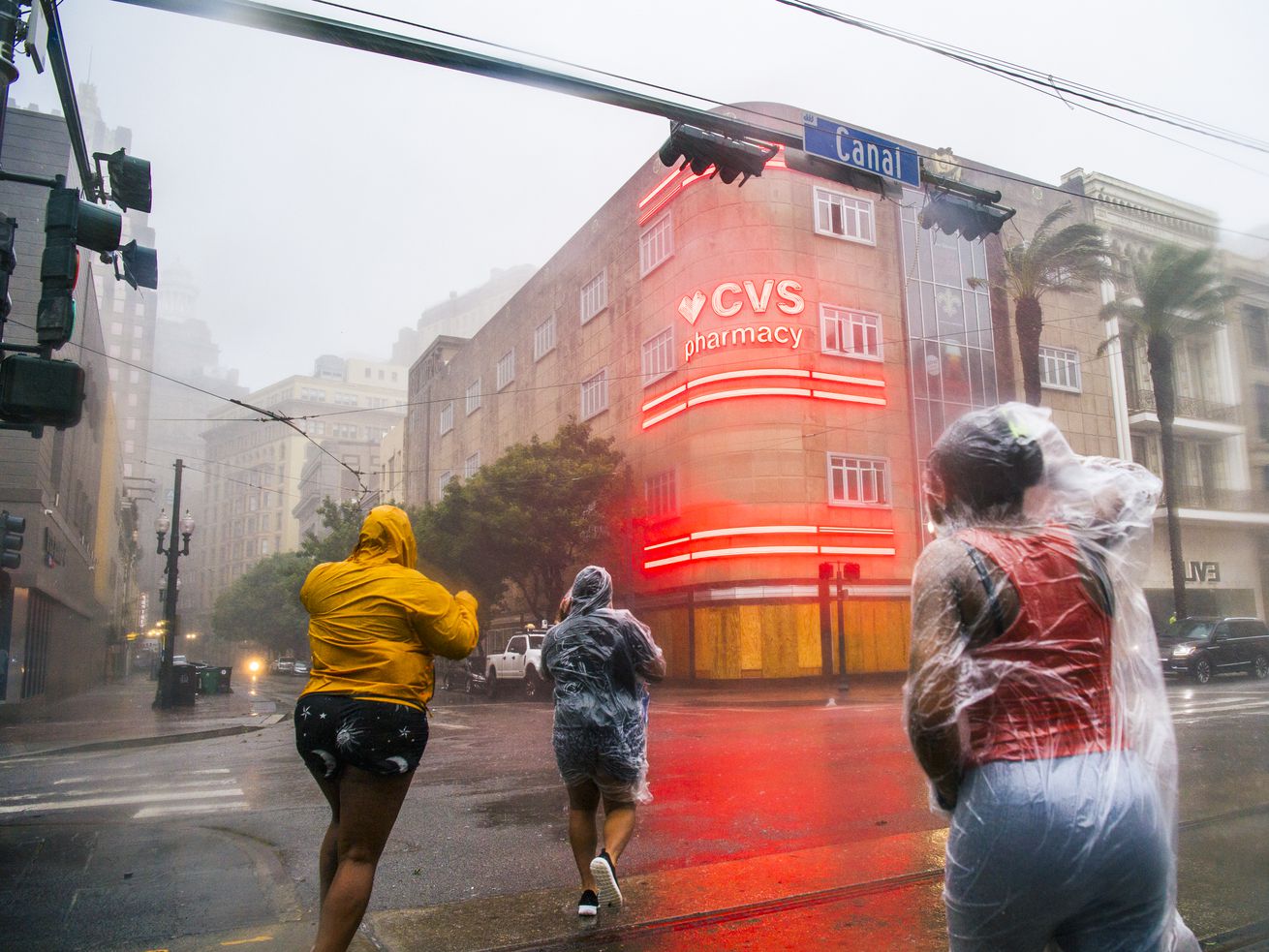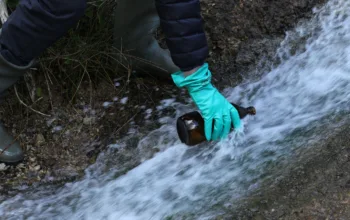Rising seas, a warming world, and Covid-19 are shaping the impact of “one of the strongest storms to ever hit Louisiana.”
Hurricane Ida made landfall in Louisiana on Sunday, the 16th anniversary of Hurricane Katrina, as an enormous Category 4 storm with sustained winds of 150 miles per hour and gusts up to 172 mph. The storm tore roofs off buildings, flooded homes, and left the entire city of New Orleans in the dark.
Ida will likely be one of the worst extreme weather events of 2021, a year already swelling with heat waves, wildfires, droughts, and storms. “Hurricane Ida is one of the strongest storms to ever hit Louisiana,” Gov. John Bel Edwards said in a statement on Sunday.
The storm is still churning and turning east through Mississippi. Though Ida has been downgraded to a tropical storm, more devastation is likely in store. The nation will learn more about local impacts as communities regain access to electricity and spotty communications. Even after the winds die down, the towering storm surge will likely linger for days and impede rescue and recovery efforts. So will the coronavirus pandemic: Less than half of Louisiana’s population is vaccinated, and 2,600 patients were hospitalized for Covid-19 as Ida made landfall.
/cdn.vox-cdn.com/uploads/chorus_asset/file/22815271/GettyImages_1234950015.jpg) Patrick T. Fallon/AFP via Getty Images
Patrick T. Fallon/AFP via Getty Images/cdn.vox-cdn.com/uploads/chorus_asset/file/22815307/GettyImages_1337165455_copy.jpg) Scott Olson/Getty Images
Scott Olson/Getty ImagesThe size and uncanny timing of Hurricane Ida makes it impossible to avoid comparisons to Hurricane Katrina, the 2005 storm that killed at least 1,170 people and tied 2017’s Hurricane Harvey as the costliest disaster in US history. While levees appear to have protected much of the state from Katrina-level flooding so far, some similarities are likely to emerge: Structural inequities and vulnerabilities remain, and communities of color are still at high risk from hurricanes like this.
But much of Katrina’s toll in human suffering and devastation became visible in the days and weeks after the storm, in part due to a botched relief effort. It will take time to figure out whether Louisiana, the city of New Orleans, and the US as a whole learned the lessons of Katrina in advance of Ida.
“People think of a few common themes when they think about hurricanes in New Orleans,” including levees and the legacy of Hurricane Katrina, Lamar Gardere, executive director of the Louisiana nonprofit the Data Center, wrote to Vox on Sunday, shortly after evacuating the city. “But every hurricane boils down to a story about infrastructure, inequity, and climate change/coastal land loss.”
“These are the same stories that affect much of our country, but they come into acute focus with immediate and dramatic effect during these events,” Gardere added.
Cities along the Gulf Coast have spent billions over the past decade and a half building up their defenses — levees, sea wall, flood control mechanisms. But populations have grown, the oceans have risen, and the planet has warmed. The threat of extreme weather is growing, and it’s becoming harder to adapt.
The factors fueling Hurricane Ida’s destruction, explained
The Gulf Coast is especially vulnerable to tropical storms
Millions of people live in the US Gulf Coast, which is one of the country’s fastest-growing regions and stretches across Texas, Louisiana, Mississippi, Alabama, and Florida. Between 2000 and 2016, the population in the region grew by 25.4 percent, compared to 14.8 percent across the US as a whole.
That in turn has fueled a construction boom of homes, businesses, infrastructure, and industrial facilities, particularly for the oil and gas sector. Ida made landfall near Port Fourchon, an oil and gas hub that experienced some of the storm’s most extreme winds and storm surges. Much of the new construction is in low-lying areas prone to coastal inundation, with some places lying below sea level.
/cdn.vox-cdn.com/uploads/chorus_asset/file/22815312/GettyImages_1234964819.jpg) Luke Sharrett/Bloomberg via Getty Images
Luke Sharrett/Bloomberg via Getty ImagesParts of the Gulf Coast are sinking as the soft ground settles beneath heavy construction and changes in land use, a phenomenon known as subsidence. The coastline itself, which can serve as a barrier against storms, is wearing away as rising seas erode the shore. Changes to waterways like the Mississippi River have also diminished vital sources of sediments for replenishing the coast.
All this means that lots of people and property are in harm’s way when disasters occur. And Ida took an especially destructive course through major population centers.
The risks, however, are not distributed equally. Many lower-income communities and those populated by people of color have less protective infrastructure like levees and sea walls, leaving them vulnerable to storms and rising water. The people in these communities also often have the most difficulty getting out of the path of the storm as they struggle to find adequate money and shelter to evacuate.
2021 already looks like a worse-than-usual hurricane season
In May, the NOAA forecasted that the US Atlantic hurricane season, which runs from late May until the end of November, had a 60 percent chance of being “above normal.” So far, that prediction has come to pass. “After a record-setting start, the 2021 Atlantic hurricane season does not show any signs of relenting as it enters the peak months ahead,” said Rick Spinrad, NOAA administrator, in an August statement.
This year’s season is below the record-breaking season last year, which was the busiest on record. But there are several factors this year that are fueling a more active year for tropical cyclones.
Ordinarily, a key factor is sea surface temperature. Hurricanes need water to be at least 26 degrees Celsius, or 79 degrees Fahrenheit, and the warmer water gets, the more energy is available to form storms. Water temperatures in the Gulf spiked ahead of Hurricane Ida, but sea surface temperatures in the North Atlantic this year have generally been near average levels. Still, forecasters are anticipating a stronger West African monsoon, which helps birth hurricanes.
Meteorologists are also expecting less vertical wind shear in the atmosphere, which are changes in wind speed and direction that can rip apart hurricanes before they form. Another factor that favors more active hurricane seasons: Since 1995, the Atlantic Ocean has been in the warm phase of a decades-long ebb and flow in ocean temperatures, known as the Atlantic Multi-Decadal Oscillation.
The climate is changing and making hurricanes more damaging
The planet is warming due to emissions of greenhouse gases from burning fossil fuels. That amplifies the raw ingredients of hurricanes and can worsen storms.
While researchers are still parsing the climate signals in Hurricane Ida, scientists have known for decades that climate change worsens hurricanes for several reasons. Sea surface temperatures are rising, which infuses storms with more energy and can increase their intensity.
“As the climate warms, we expect that the upper bound of how intense a hurricane can get … goes up at a certain rate with warming and that’s been known for 33 years,” Kerry Emanuel, a professor of atmospheric science at the Massachusetts Institute of Technology, told Vox last year.
Another way climate change makes hurricanes more destructive is by increasing their rainfall. Air soaks up about 7 percent more water for every degree Celsius the air warms, so warmer air means more moisture is available for precipitation. Extreme rainfall events are on the rise, and Ida drenched parts of Louisiana with as much as 24 inches of rain.
/cdn.vox-cdn.com/uploads/chorus_asset/file/22815331/GettyImages_1234961418.jpg) Sean Rayford/Getty Images
Sean Rayford/Getty ImagesRising sea levels due to the melting of ice caps and the thermal expansion of water are leading to larger storm surges, too. This coastal flooding, driven by a storm’s winds pushing water inland, is often the deadliest and most destructive element of hurricanes. Ida created a storm surge as high as 16 feet.
Climate change is also causing the rapid intensification of more hurricanes. NOAA defines rapid intensification as a gain of 35 mph or more in wind speed over 24 hours. Ida strengthened from category 2 strength (with winds up to 110 miles per hour) to category 4 strength (with winds topping 150 mph) in less than a day. Hurricanes tend to rapidly intensify when they pass over a patch of water that is warm, deep, and calm. These changes in wind speed can make the difference between a building surviving a hurricane and being obliterated by it.
Covid-19 is compounding the disaster
Experts have been warning for more than a year that a hurricane striking during a pandemic would pose unique challenges, and health officials are worried more difficulties may arise in the wake of Hurricane Ida.
“We’re having a situation where even when you’re stretched to the limit — to superimpose upon it what will likely be a historic weather environmental catastrophe — is going to do nothing but make things much, much worse,” Anthony Fauci, director of the National Institute of Allergy and Infectious Diseases, told CNN on Sunday.
Hospitals are contending with power outages, and many are unable to relocate their patients because other medical facilities in the region are already full of Covid-19 patients.
For evacuees in shelters, it’s proving hard to maintain social distance. The risk of further transmission is high, given relatively low vaccination rates across the Gulf Coast and the spread of the more-transmissible delta variant.
People of color, including Indigenous communities, are on the front lines of Hurricane Ida
Hurricane Katrina took a devastating toll on communities of color, and advocates fear these communities will again suffer some of the worst impacts of Hurricane Ida.
Indigenous communities in the bayou have been hit by catastrophic flooding, said Donny Verdin, a member of the tribal council of the United Houma Nation. “We have people who stayed behind whose houses were flooding and roofs were blown off as they were in them,” Verdin, who evacuated to Texas on Saturday, told Vox on Monday.
The United Houma Nation is typically overlooked by federal relief, Verdin said, because it’s not a federally recognized tribe. In the aftermath of Hurricane Katrina, he said, his community relied on donations and nonprofit organizations instead of support from the federal government. “We’re just left to fend for ourselves,” he said. “The community usually pulls together and we build back. It’s what we’ve done forever.”
Storms and sea-level rise fueled by climate change have been pushing tribes further inland, away from their traditional territories. The majority of Verdin’s community used to live right on the coast: “We are people of the water,” he said. After Katrina, three-quarters of them moved inland, Verdin told Vox.
/cdn.vox-cdn.com/uploads/chorus_asset/file/22815381/GettyImages_1234965344_copy.jpg) Patrick T. Fallon/AFP via Getty Images
Patrick T. Fallon/AFP via Getty Images/cdn.vox-cdn.com/uploads/chorus_asset/file/22815348/GettyImages_1234964902.jpg) Luke Sharrett/Bloomberg via Getty Images
Luke Sharrett/Bloomberg via Getty Images“The community is not as close as it once was because people are more scattered,” he said. “The best-case scenario is that we are able to relocate our communities. The worst-case scenario is that they wash away.”
Relocating communities who have lived in coastal Louisiana for generations comes at a steep cost. “Our access to the natural resources and food security has been everything for our sovereignty,” said Monique Verdin (no direct relation to Donny Verdin), another member of the United Houma Nation who works with the community group Another Gulf is Possible. “When you take the people away from the bayou you’re literally taking them away from their ability to feed themselves.” Plus, at the end of the day, she told Vox, “you can’t run from climate change.”
Time will tell whether the US has learned the lessons of Katrina
It’s hard not to draw ties between Hurricane Ida and Hurricane Katrina, one of the most expensive storms in US history. The storms landed on the same day of the year and in roughly the same spot. They had similar wind speeds. They even gained strength by passing over a similar patch of warm ocean water in the Gulf that fuels hurricanes, the AP reported.
There are some important differences in the storms themselves — Ida caused a weaker storm surge but had stronger winds, for example. But even if all things were considered equal, Ida is likely to be far less devastating than the 2005 storm.
Katrina was destructive in part because of structural issues with the region’s system of levees — many of which failed — and a botched government response to the crisis, as Vox’s German Lopez previously reported. Here’s how Lopez put it:
The government response was so wildly incompetent that it allowed the worst of the catastrophe to continue and sometimes created entirely new, unnecessary problems. People will always have to deal with unavoidable natural disasters, but a poor government reaction and preparation can lead to many more deaths and untold costs.
The US government also failed to evacuate tens of thousands of people who couldn’t afford to leave Louisiana before the storm hit, Lopez reported.
The levee system is much stronger today, after a $14.5 billion investment in storm protection authorized by Congress in the wake of Hurricane Katrina. The Army Corps of Engineers has since constructed hundreds of miles of levees around New Orleans, Reuters reported, some of which are 30 feet tall. They appear to be working, with only a small number of levee failures reported outside of the city. The governor said on Monday that the state’s storm protection system performed “extremely well,” after stating earlier that they were “built for this moment.” (His office did not immediately respond to a request for comment.)
The details of Hurricane Ida’s devastation will trickle out for days to come, as officials survey the damage and conduct search-and-rescue operations. “I fully expect [the] death count will go up considerably throughout the day,” the governor told MSNBC on Monday.
And if past hurricanes are any guide, the government’s ongoing response to the storm — including its long-term follow-through — will shape the region’s recovery and its resilience to future hurricanes.
There will be more storms, and in a warming world, they’ll get worse.
Daniel A. Gross contributed reporting to this article.
Author: Umair Irfan
Read More



